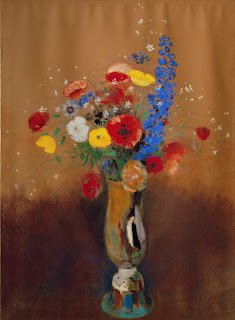Tuesday, March 10th, 2009
Redon’s Flowers and Cezanne
Although Odilon Redon is best known for his fanciful, pre-Surrealist works like The Cyclops, I am particularly drawn to his still-lifes of flowers in vases. I’m actually quite surprised by this, because I am rarely attracted to still-life paintings. Last fall, when I went to visit the “Monet to Picasso” exhibition at the UMFA, this was my favorite painting in the show:
 Vase of Flowers, c. 1905 (Cleveland Museum of Art)
Vase of Flowers, c. 1905 (Cleveland Museum of Art)
In a letter to Emile Bernard, Cezanne mentioned that he “liked Redon’s talent enormously.”1 This statement has given some reason for art historians to compare and contrast Cezanne and Redon. In an essay, Rachel Frank argues that “the differences are…striking” between between Redon and Cezanne.2. Although I can agree with Frank to a degree, I see some similarities between Redon and Cezanne, primarily that both artists often apply paint in large patches of color. I especially like the “patches” on the vase (i.e. the blues, browns, whites, and blacks) of the following still-life:
 Wild Flowers, gouache, c. 1912 (Musée d’ Orsay)
Wild Flowers, gouache, c. 1912 (Musée d’ Orsay)
Nonetheless, I think that these artists mutually influenced each other during their careers. It seems difficult for artists to not be influenced (whether it be deliberate or unintentional) by their contemporaries. What do you think? Do you see similarities or differences between Redon and Cezanne’s styles?
If you like paintings of Redon’s flowers in vases, you can see more of them here.
2 Rachel Frank, “Cezanne and Redon,” The Hudson Review 4, no. 2 (Summer, 1951): 269
3 Dario Gamboni, Potential Images: Ambiguity and Indeterminacy in Modern Art, (London: Reaktion Books, 2002), 132. Citation can be read online here.
4 Ibid.
I am unprepared to state an educated opinion on the matter, as I am unsure of what the differences between Cezanns’ formalism and Redon’s symbolism could be. Enlighten me?
I wondered if perhaps I didn’t explain myself well enough.
When I mentioned formalism, I was referring to Cezanne’s interests in the formal aspects of the objects that he portrayed. In other words, Cezanne was interested in the flatness of figures, the geometricity of shapes, the flatness of the canvas, and the flat effect that was created by applying “patches” of color.
I think Redon, however, wasn’t interested in creating or emphasizing flatness through his color “patching.” He seems to be more interested in creating aesthetically-pleasing color combinations and juxtapositions. This makes sense to me, since Redon was a member of the Symbolist movement. This group was interested in many things, including an emphasis on aesthetic issues, emotion, and feeling.
So, even though I see similarities in the way that these artists applied paint to the canvas, I respond differently to their art (which I think is a good thing, because these artists had different artistic interests and aims).